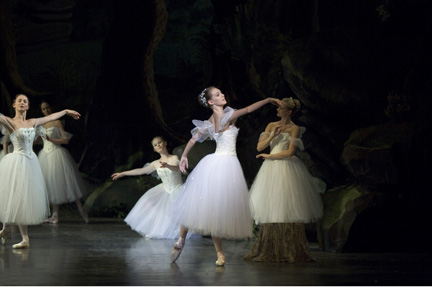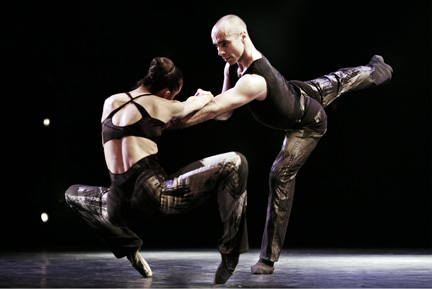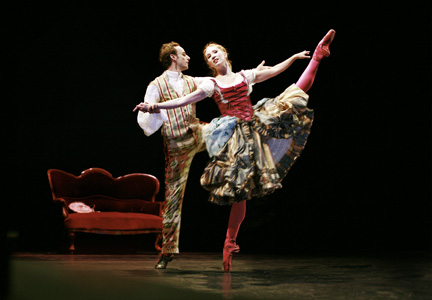The Royal Danish Ballet — the next generation
The Royal Danish Ballet
The Lesson/"La Sylphide" (new Cast)
November 14 2006
by Eva Kistrup
copyright 2006 by Eva Kistrup
 On November 14, I counted eight interpreters of the coveted Sylph in "La Sylphide" in the Royal Theatre, three in the audience and five on stage. The eight dancers were Anna Lærkesen, Lis Jeppesen, Mette-Ida Kirk, Mette Bødtcher, Rose Gad, Silja Schandorff, Gudrun Bojesen and the debutante Sylph of the night, young Christina L. Olsen in her first major role. Seeing the past and present sylphs brought the recognition that there is neither a physical nor an interpretive prototype for the Sylph. It also became very clear that Christina L. Olsen (not to be confused with principal and former sylph Christina Olsson) was handed so much more than a plum role.
On November 14, I counted eight interpreters of the coveted Sylph in "La Sylphide" in the Royal Theatre, three in the audience and five on stage. The eight dancers were Anna Lærkesen, Lis Jeppesen, Mette-Ida Kirk, Mette Bødtcher, Rose Gad, Silja Schandorff, Gudrun Bojesen and the debutante Sylph of the night, young Christina L. Olsen in her first major role. Seeing the past and present sylphs brought the recognition that there is neither a physical nor an interpretive prototype for the Sylph. It also became very clear that Christina L. Olsen (not to be confused with principal and former sylph Christina Olsson) was handed so much more than a plum role.
With the majority of the present principals and soloists in their mid- and late thirties, Ballet Master Frank Andersen is busy testing out the younger dancers in leading roles. But like his first tenure as ballet master in the mid-80s, casting seems very confused and he is spreading the net a bit too wide. Too many dancers are cast in roles not suited to their talents, leading to a situation where the real talents get too few parts in which they can grow and seldom dance the roles for which they are best suited. Classical ballet is not democratic and choices must be made and substantiated by a clear artistic line and good talent management. There is no doubt that Christina L. Olsen is a great talent, yet handing her the Sylph when she has few dramatic parts under her belt seems strange. She is a tall willowy dancer with a clean schoolgirl appeal, not an alluring mysterious stage persona, and with a conductor forcing the tempi, she was in deep water technically and did not really show herself as the next great Sylph. And yet she might have been triumphant in another role and with better preparation.
 Instead of pairing her with a young James, Olsen was partnered by the great and experienced Mads Blangstrup who, like Silja Schandorff at the repremiere, had to work hard to keep the performance together. A lot of the problems were casting related. Why team the tall cast with the smallest witch? How can she be a towering presence in tall company? And why not cast a young couple instead of pairing them with dancers of another generation? To me it looks like indecision and lack of confidence in the younger dancers. Last year Sebastian Kloborg and Susanne Grinder were a strong Romeo and Juliet; since then, they have had next to nothing role wise. This is not the way to produce stars, and ballet needs stars.
Instead of pairing her with a young James, Olsen was partnered by the great and experienced Mads Blangstrup who, like Silja Schandorff at the repremiere, had to work hard to keep the performance together. A lot of the problems were casting related. Why team the tall cast with the smallest witch? How can she be a towering presence in tall company? And why not cast a young couple instead of pairing them with dancers of another generation? To me it looks like indecision and lack of confidence in the younger dancers. Last year Sebastian Kloborg and Susanne Grinder were a strong Romeo and Juliet; since then, they have had next to nothing role wise. This is not the way to produce stars, and ballet needs stars.
In the Mozart programme at Takkelloftet (the small stage,) stars Thomas Lund and Gudrun Bojesen were the only positive thing on a programme employing six dancers in all and combining the task of covering Nordic modern choreography and celebrating the Mozart year. According to the programme, none of the three choreographers—Pär Isberg, Jorma Elo and Louise Midjord—had any inclination to use Mozart music, nor, unsurprisingly, will their work become part of the ballet canon. Why force choreographers into areas they see no artistic need to conquer? Jorma Elo's "10 to Hyper M" is a mainstream abstract modern pas the deux with dancers in smart jeans and black tops, tuff attitude, and gave little to applaud save its hardworking dancers. Louise Midjord, musically straying from the Mozart tradition by using electronic music, presented a pastoral (No Title) with a young man posing as a deer to attract the shepardess. Lasting interest? Not likely.
 Finally Pär Isberg has created a sort of Mozart–Constance pas de deux "In Search of..." for Bojesen and Lund, and then something finally happened. The pas de deux celebrated the partnership between two dancers,who have chosen to link together their careers. Strictly speaking the pas de deux ís more an act than a work of art, and Bojesen and Lund will be able to travel with this charming bagatelle that allows both dancers to show their skills at the piano, fine solos, and a striptease from full rococo gear to modern underwear. But a partnership like Lund’s and Bojesen’s is one of the best selling aspects of the company and should be used in more and better works and as a model for how to create new stars and new partnerships. It was not much to gain from a ballet programme but it saved the programme from being a total waste of time and effort.
Finally Pär Isberg has created a sort of Mozart–Constance pas de deux "In Search of..." for Bojesen and Lund, and then something finally happened. The pas de deux celebrated the partnership between two dancers,who have chosen to link together their careers. Strictly speaking the pas de deux ís more an act than a work of art, and Bojesen and Lund will be able to travel with this charming bagatelle that allows both dancers to show their skills at the piano, fine solos, and a striptease from full rococo gear to modern underwear. But a partnership like Lund’s and Bojesen’s is one of the best selling aspects of the company and should be used in more and better works and as a model for how to create new stars and new partnerships. It was not much to gain from a ballet programme but it saved the programme from being a total waste of time and effort.
Photos:
Christina L. Olsen as the First Sylph in Act II of "La Sylphide." Photo by Martin Mydtskov Rønne.
Marie-Pierre Greve and Jean-Lucien Massot in Elo's "10 to Hyper M." Photo by Morten Abrahamsen.
Thomas Lund and Gudrun Bojesen in Isberg's "In Search of. . .". Photo by Morten Abrahamsen.
Volume 4, No. 41
November 20, 2006
copyright ©2006 Eva Kistrup
www.danceviewtimes.com